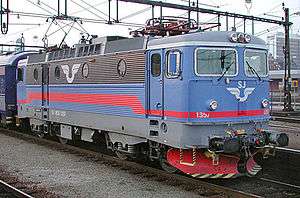SJ Rc
|
Rc6 operated by SJ | |||||||||||||||||||
| |||||||||||||||||||
| |||||||||||||||||||
| |||||||||||||||||||
The SJ Class Rc is the most used electric locomotive in Sweden. Rc is a universal locomotive used both in freight and passenger trains. The largest operator is Green Cargo, although SJ, Veolia Transport, Tågåkeriet, Hector Rail and the Swedish Transport Administration operate it as well.
History
The Rc-locomotive first appeared in 1967 to replace the 1950s Ra-locomotive, the 1940s F-locomotive and the older D- and Da-locomotives.The locomotives are notable for using thyristors instead of the older diode based system.
Usage
As of 2007, Green Cargo operated the Rc locomotives on the iron ore line between Kiruna and Gällivare in Northern Sweden. [1]
Versions
Altogether there have been 8 versions of the Rc-locomotive in Sweden including the freight locomotive Rm designed to pull iron ore trains. Rc1, Rc2, Rc4, and Rc5 have a maximum allowed speed of 135 km/h. Rc3 and Rc6 have a maximum allowed speed of 160 km/h. Rc7 was a rebuild of Rc6 meant to haul replacement trains needed when the X 2000 trains were canceled or delayed. Rc7 had a maximum allowed speed of 180 km/h. However, the maximum speed permitted without emergency electromagnetic track brakes is 160 km/h, and converting the carriages proved too expensive. For that reason all Rc7 were subsequently converted back to Rc6. Rc1–Rc7 all weigh between 75 and 80 tonnes, whilst the Rm weighs 90 tonnes. The Rm's top speed is only 100 km/h, but due to the nature of their work, they are more powerful locomotives.
Exports
Engines based on the Rc design has been sold to other countries. The Austrian Federal Railways bought 10 Rc2 with extra brakes for the alpine conditions, ÖBB Class 1043. One of the locos was badly damaged in an accident but the remaining nine have been bought by the Swedish company Tågåkeriet i Bergslagen AB (TÅGAB), and returned to Sweden. A slightly altered Rc4 has been sold to Norwegian State Railways of Norway, known as El 16. The RAI 40-700 class (see Iranian Railways RC4) of eight engines were exported to Iran in the early eighties for use on the electrified stretches near the then-Soviet border; these were based on Rc4 but with Rm-type bogies, sand-proof air filters and no round windows on the side. In 1977, an Rc4 was tested in the United States for use with Amtrak's passenger trains. The Rc4 engine proved successful and would become the basis for the AEM-7.
Refurbished units
42 class locomotives are being refurbished by Bombardier for Green Cargo. They include various upgrades and are now known as class Rd.[2]
| Model | Operator | Built | Years | Power | Top speed | Note |
|---|---|---|---|---|---|---|
| SJ Rc1 | Green Cargo | 20 | 1967–68 | 3,600 kW | 135 km/h | |
| SJ Rc2 | Green Cargo, TågAB, Infranord | 100 | 1969–75 | 3,600 kW | 135 km/h | |
| SJ Rc3 | SJ AB and Green Cargo Hector Rail (which renamed them to type 143) | 33 | 1970–71 | 3,600 kW | 160 km/h | 23 rebuilt from Rc2, 13 later sold to Green Cargo and Hector Rail |
| ÖBB Class 1043 | Tågab and Swedish Rail Administration and TGOJ | 9 | 1971–73 | 4,000 kW | 135 km/h | |
| SJ Rc4 | Green Cargo | 130 | 1975–82 | 3,600 kW | 135 km/h | 160 km/h for Rc4P |
| SJ Rm | Green Cargo | 6 | 1977 | 3,600 kW | 100 km/h | Cargo-only locomotives for use on the Ore Route. |
| NSB El 16 | CargoNet | 17 | 1977–84 | 4,440 kW | 135 km/h | |
| AEM-7 | Amtrak, SEPTA, MARC | 65 | 1978–88 | 5,200 kW | 201 km/h | Amtrak's locomotives retired 2016, MARC's locomotives retired 2018 |
| RAI 40-700 class | Islamic Republic of Iran Railways | 8 | 1982 | 3,600 kW | 100 km/h | |
| SJ Rc5 | Swedish Transport Administration (("SSRT") owner without own operation) | 60 | 1982–86 | 3,600 kW | 135 km/h | All now converted to Rc6 |
| SJ Rc6 | SJ AB and Swedish Transport Administration (("SSRT") owner without own operation) | 40 | 1982–86 | 3,600 kW | 160 km/h | 60 rebuilt from Rc5 |
| SJ Rc7 | SJ AB | 2 | 2001 | 3,600 kW | 180 km/h | Rebuilt from Rc6, all now converted back to Rc6 |
Gallery
 Two Rc4 and a Rc2 (in the middle) of Green Cargo
Two Rc4 and a Rc2 (in the middle) of Green Cargo Banverket construction train hauled by a formerly Austrian Rc2 engine
Banverket construction train hauled by a formerly Austrian Rc2 engine TÅGAB Rc2 (also ex-ÖBB) with an empty wood train near Hallsberg.
TÅGAB Rc2 (also ex-ÖBB) with an empty wood train near Hallsberg. Rc4 in old SJ colors, owned by Green Cargo.
Rc4 in old SJ colors, owned by Green Cargo.- Rc6 in the new black SJ livery, at Luleå C
- Rc6 in silver-and-red SSRT livery, operated by SJ, at Luleå C
 A derailed Rc4.
A derailed Rc4.
References
- ↑ Östlund, A.; et al. (2008). CONDITION MONITORING OF PANTOGRAPH CONTACT STRIP (PDF). 4th IET IEEE International Conference on Railway Condition Monitoring, Derby, England. pp. 1–6. Retrieved 2 February 2014.
- ↑ "Railway Gazette: Modernised locomotives handed over to Green Cargo". Retrieved 2010-11-28.
External links
| Wikimedia Commons has media related to SJ Class Rc. |
